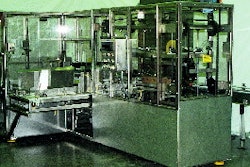In early '95, Ocean Spray automated the inspection of hot-fill juice bottles at its plant in Kenosha, WI. The result is less downtime, increased productivity and reduced labor costs, all equaling payback in less than one year. The Model 51R41 vision system from White Cap (Downers Grove, IL) includes a camera and lens, video monitor, real-time processor from Allen-Bradley (Milwaukee, WI), a computer and mouse. It detects bottle fill height, closure application, as well as the presence or absence of a cap liner and tamper-evident neck band. Ocean Spray uses the system on one of eight filling lines at the plant that hot-fills 15 juice varieties into 60-, 64- and 128-oz bottles made of polyethylene terephthalate. The line runs at speeds exceeding 200 bpm, operating every day, 'round the clock. Bottles are depalletized, uncased, cleaned, filled, capped and inspected by the vision system, then cooled prior to downstream labeling, case packing and palletizing. Reliability required "We started looking into vision systems when we began to fill PET bottles in '92," recalls Steve Daniels, a technical specialist for Lakeville, MA-based Ocean Spray. He helped orchestrate the automated vision system installation in Kenosha. Before the White Cap system was installed, the line relied on three systems: a dual-belt configuration whereby bottles were physically squeezed to check for bad closure-to-bottle seals, a fill-level scanner, and a modified metal detector that was used to check for missing or misapplied caps. Ocean Spray initiated its search for a more automated, accurate inspection process, but Daniels notes, "We felt that post-capping inspectors that existed for hot-fill PET bottles weren't reliable." Part of Ocean Spray's difficulty had to do with the hot-filling process. "When you hot-fill [at 180°F], the bottle becomes somewhat flexible," he explains. This, he says, leads to height variations. "With the system we were using, we had to constantly make adjustments for different bottle heights because many bottles were being rejected even though the fill was good. That caused considerable downtime and increased our labor costs." Bottle height variances also caused headaches with an earlier mechanical system Ocean Spray had used to detect cap application. "It just wasn't reliable," says Daniels. "We wanted to install a system that could give us virtually 100-percent accuracy." Repeatability = reliability After attending a seminar on vision systems, Daniels recommended that Ocean Spray purchase a system that previously hadn't been used for bottle inspection. Working with White Cap and Allen-Bradley, Ocean Spray adapted the system to meet the needs of the hot-fill line in Kenosha. The plant served as somewhat of a test site for the system, which has since been adopted by five additional Ocean Spray beverage lines at four other U.S. plants. The new 51R41 vision inspection system is located just downstream of the capping station on the line. It includes an upper and lower enclosure. The upper enclosure comprises a video monitor, computer mouse, strobe light, camera and lens, and photoeye. The lower enclosure houses a computer, configurable vision input module (CVIM) and programmable logic controller. As filled and capped bottles pass the vision system, mounted above the conveyor, a photoeye detects bottle presence. A monochrome video camera and 55mm lens acquire an image of the bottle. A strobe provides light. Once the strobe fires, the camera sends the image to the Allen-Bradley processor for inspection. The processor compares the image with acceptable parameters established by Ocean Spray, to make accept/reject decisions for each bottle size and product flavor. Each size/flavor is assigned a "tool set" that includes a series of windows, gauges and reference lines used to measure and inspect a particular image. These tool sets are accessed through the CVIM. A video monitor allows operators to view bottles as they pass the inspection point. By using a mouse, the user can point to areas on the screen that represent specific bottle areas to make necessary changes. "The system uses the neck of the bottle as a reference point," Daniels explains. "That reference point lets us inspect for cocked or missing caps, how far the cap is torqued on, the presence, absence or damage to a cap liner or tamper-evident band. "We can determine the lightness and darkness of pixels within an image to help determine fill heights, too," he explains. "With apple juice, for example, which is light in color, more light will shine through the bottle, so that presents a different set of pixels than cranberry. We use pixel color to help determine defects. "With this system," he adds, "changeovers are easy, too. We set the unit for the proper fill height, use the mouse to call up the proper 'tool set,' and in about five minutes the inspection system is ready for another size or flavor." Daniels says that the vision system, "has become an effective tool for us in terms of troubleshooting and data storage. With the PC-based system, data is stored electronically. In the past, we needed people to back up our mechanical systems and track information such as the number of good bottles versus rejects on a particular run. Now it's all saved in the computer. "That cuts down considerably on our labor costs. It gives us the 100-percent reliability we were seeking, and it has greatly increased our productivity compared with the mechanical systems we had used that caused us considerable line downtime."
























